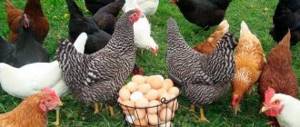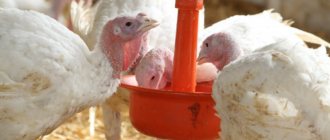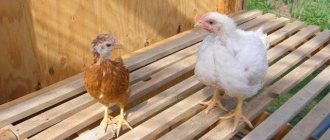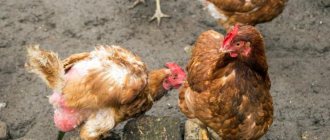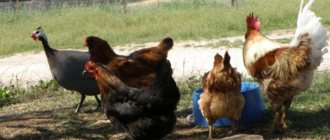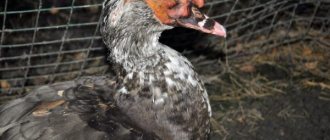Features of keeping adult chickens together
Both chicken trends have both similarities and differences in habits, living conditions and diet. To ensure that their coexistence does not create problems for either the owner or the pets, you need to be able to eliminate conflicts of interest as much as possible.
Similarities between Layers and Broilers
So, the conditions of detention for both directions:
- dry, insulated chicken coop with an effective ventilation system;
- absence of dampness, drafts, cracks in walls and floors;
- a good layer of clean and dry bedding;
- a sufficient number of feeders and drinkers (nipple option is better);
- the design of closed feeders to prevent birds from scattering food;
- suitable temperature conditions;
- ash baths;
- spacious and comfortable perches for relaxation;
- lighting and ventilation;
- sanitary treatment of the chicken coop;
- cleanliness of food and drinking utensils, cleanliness of bedding;
- vaccination against diseases;
- regular inspection of birds for parasites or diseases;
- disinfection of the premises if necessary.
All of the above conditions are important both for weight gain in broilers and for the productivity of laying hens. Cleanliness in the room and in the feeders will prevent the development of conditions for the appearance of pathogenic bacteria.
The absence of humidity, drafts and cracks is a precaution against hypothermia of birds and against the penetration of parasites and small rodents into the house. Fresh water should always be available
Fresh water should always be available.
Ash baths are no less important for birds: by bathing in them, the birds themselves cleanse their skin and feathers of dirt and parasites. Ash baths Chickens are shy birds, so it is advisable to place the chicken coop in a quiet, peaceful place.
The most basic difference lies in the names of the hens' directions: laying hens bring eggs to the owner, broilers bring meat. Different focus implies differences in the following:
- diet and diet;
- behavior and pastime;
- resting-place.
It is not advisable for egg-laying chickens to gain excess weight; they are fed according to a certain regimen - three to four times a day. At the same time, the diet is dominated not by fats, but by proteins and vitamins and minerals. Broilers are fed richly, including nutritional supplements in the feed that promote weight gain. You need to immediately think about the number of feeders, otherwise the fast laying hens will constantly deprive the slow broilers of food, and in addition, the birds may fight for food. The same goes for drinking bowls: there should be enough of them, and to prevent birds from turning over bowls of water and contaminating them, it is better to make a nipple version.
The bird walking is also excellent. Broilers are characterized by slowness and passivity, they even often eat in a lying position. The restlessness of laying hens and the desire to dig around and look for something can irritate meat birds. Dividing the walking area will help to avoid fights between them. A chicken coop with two paddocks. Also, the slowness and clumsiness of broilers can provoke aggression in laying hens. Therefore, it is advisable to make two separate entrances and exits for them - a low hole for meat pets, a ladder for egg birds.
It is also advisable to think about separate perches: egg hens like to rest higher up, and broilers are happy with bedding on the floor - they need perches not high from the floor. To prevent a crush from forming when climbing to the perches, you need to install a ladder for the egg birds.
Diseases in chickens kept together
If there are too many chickens in the house, they are more likely to develop various diseases. Infectious diseases are especially developed in this poultry if the room is damp, the air temperature is low, and also due to drafts.
Signs of infectious diseases in poultry:
- Rhinitis;
- cough;
- hoarseness;
- individuals are lethargic;
- loss of appetite.
The bird should be treated with the following medications:
- Tetramisole;
- Enroxil;
- Baycox.
The chicken coop should be insulated and disinfected.
Often, poultry may develop diarrhea, not only due to infectious diseases, but also due to salmonellosis or colibacillosis. All sick individuals must be isolated from the main population and appropriate treatment must be carried out.
Representatives of broiler breeds often have diseases of the limbs, which is associated with a lack of vitamins and minerals in their body. The first sign of such diseases are individuals falling out of the blue, as well as an uneven gait.
What not to feed chickens
| What not to feed chickens | Why can't you feed chickens this? |
| Raw green potato peel | The toxic substance is called Solanine. |
| Something really salty | May cause salt poisoning. |
| Citrus | Chickens also suffer from allergies. |
| Beans are dry or undercooked | Raw or dried legumes contain a poison called hemaglutin, which is toxic to birds. |
| Candy, chocolate, sugar | Chickens will develop tooth decay... no, it's just bad for them, and chocolate can be poisonous to most pets! |
| Raw eggs | You don't want to introduce your laying hens to the taste of eggs that are already lying in nests waiting to be collected. |
I was disappointed in my laying hens, studying what to feed the chickens, what is best for them, at the moment when I caught them all, when they had almost finished dealing with the foam from the packaging from the juicer...
What are the benefits of broiler eggs?
Broilers are large in size and lay fairly large eggs.
Food eggs
The size of broiler eggs is large and their weight on average reaches 60–65 g. Among them, specimens with 2 yolks are somewhat more common than in other breeds. The nutritional value of egg products from broiler chickens is the same as that of conventional laying hens. American researchers compared the composition of broiler eggs with the products of other breeds, but did not find any differences.
Hatching eggs
Broiler hens usually lack the brooding instinct and an incubator should be used to produce their offspring. However, incubating their eggs does not make sense. Broilers are hybrids and their offspring do not inherit their high productivity. In the best case, chicks will hatch that weigh slightly more than chickens of ordinary breeds. There is also a considerable probability that the chick will not hatch at all or will be born unhealthy, because inbreeding (inbreeding) is used when breeding some breeds.
Did you know? The first broilers were bred in 1930 by crossing the English Cornish meat breed and American Plymouth rock meat and egg chickens. In the 60s of the last century, interbreeding to produce broiler chickens began to be used by most producers.
The question of whether to incubate egg products from broilers or not should be decided by a person knowledgeable in breeding broiler breeds. You need to have a lot of knowledge to try to get a broiler breed at home. It is better to buy broiler eggs for incubation from a reliable supplier or from a farm specializing in breeding broiler breeds, where professionals deal with this issue.
What can you feed chickens?
Please note that at the end of the article we provide a table of what you should not feed chickens!
Product In what form General opinions Apples Raw materials and in the form of applesauce without sugar. Apple seeds contain cyanide, but not in sufficient quantities to be harmful. Asparagus Raw or cooked. They don’t like it, but they eat it in mash. Bananas Without peel. Fruits with a high potassium content are pecked with pleasure. Beans Only well-cooked, boiled. Fresh beans and tops are eaten well. Beets In any form, give tops. Raw grate, boiled whole. Berries All types. This is the most delicious thing for chickens, take care of your plantings! Bread All types - stale pieces are best. Feed in moderation, obesity! Broccoli and cauliflower Fresh and boiled. Hang it on the wall and they'll be pecking all day long. Cabbage and Brussels sprouts Fresh and boiled. In winter, hang whole cabbages from the ceiling of the coop to give them something to play with and eat. Carrots Raw and boiled. They like carrot foliage too
Raw on a grater, but not much! Cottage cheese Super delicacy. Fat and low-fat people love Cheese. In addition to processed cheese, it is an expensive pleasure. Fatty product, but a good source of protein and calcium. Boiled chicken Eating your own kind? They may like it and it's nutritious, but it just seems...umm...wrong. Corn On the cob and canned, raw and cooked. Limited! Obesity. Crickets, bugs, worms (live) Can be bought in fishing stores (expensive). Great treat - provides protein and fun to watch the hens deal with. Cucumbers Only fresh. Cut in half, leaving only the skin. Hard boiled eggs are a good source of protein and a favorite treat. Only in cooked form! If you give them raw ones, they will start pecking at their eggs! Eggplant Raw, fresh and tops. Not everyone likes it, but they like it Fish and Seafood Only in boiled form. They also love raw fish, but we won’t risk it. Flowers Make sure they have not been treated with pesticides, only from your own flower bed. Marigolds, nasturtiums, pansies, etc. Fruits Pears, peaches, cherries, apples. They love it! Grains, cereals Any. No comments needed! Grapes Only without seeds. For chickens, cutting them in half makes them easier to swallow. Chickens play with whole grapes like football! Oatmeal It's better to steam it. They eat with pleasure. Table leftovers Any! Just not spoiled!!! We do not recommend: pickles, jams, marinades. Herbs Any leafy green that we add to dishes, fresh or dried. They like it! Yogurt Any. They eat with passion! Meat waste Not too fatty, raw and boiled, chopped. Good source of protein in moderation. Melon Seasonal buzz. Both the seeds and the pulp make good chicken treats. Oatmeal Raw cereal or leftovers from your meal. Cooked better, be careful - obesity. Pasta Cooked pasta, spaghetti, etc. A favorite treat, it's fun to watch chickens eat spaghetti. Infrequently! Peas Fresh peas and pea tendrils, leaves and flowers. They gobble it up with pleasure. Sweet pepper Fresh. Not everyone loves it! Cut pomegranates in half. The kernels are great fun. Popcorn If only without butter and salt. They'll peck quickly. Potatoes Boiled only - avoid green skins! Products with a high starch content should not be given frequently. Pumpkin Raw or cooked. Both the seeds and pulp are a nutritious treat. All kinds of raisins, but expensive. Swept away instantly. Boil rice, or cook until half cooked. Try giving pilaf - that's where the feast begins! Watermelon Rind and pulp. Peel down to the holes in the peel. Sprouts Sprouted wheat, oats. This is instead of greenery in winter. Zucchini, zucchini All varieties, raw and cooked, even squash. Not much of a treat, but some people eat it! Sunflower Seeds Sunflower seeds in the shell are good for both feeding and shelling. A good delicacy, some chickens know how to shell them, they only eat the grains! Tomatoes Raw and cooked. Not for everyone. Steamed turnip. They don't eat much.
Compatibility of different types of birds
Is it possible to keep geese, chickens and ducks together? This problem often arises among owners of small farms. It is decided depending on the territory allocated for the habitat of birds, their number and age. With proper organization of space, geese, chickens and ducks can coexist comfortably in a small area in one room.
It is worth considering that birds have their own hierarchy, with geese at the highest level. These birds are not only the largest among these types of poultry, but also the most warlike. Geese will always defend their territory, while injuring weaker individuals. Ducks, despite their considerable size, are harmless, very rarely get into fights, stay in flocks, and get along with any birds without any problems. Chickens, although they are at the lowest level of the hierarchy, are quite aggressive and noisy.
In addition to behavior, there are significant differences in the way of life of different types of birds. Chickens love cleanliness and cannot tolerate high humidity. Ducks and geese, on the contrary, breed dampness and do not stand out for their cleanliness.
To determine the possibility of combining bird species, it is necessary to consider different combinations of keeping.
Is it possible to keep chickens and ducks together?
Due to the calm and peaceful nature of ducks, they get along quite well with chickens: both laying hens and broilers. You just have to divide the territory correctly. For feeding and bathing, chickens need dry bedding, but at the same time they scatter the contents of the feeders. During the feeding process, ducks should drink everything with water, splashing it. The result is dirt and dampness.
For comfortable laying of eggs, you can arrange nests at different heights: for ducks - at the bottom, for hens - a little higher, at the level of half a meter from the floor.
Is it possible to keep chickens and geese together?
This combination of birds is quite complex, especially during the bedding-in period. Geese, in principle, are quite aggressive birds and will always assert their superiority. Only a clear division of territory, both in the poultry house and in the pasture, can save the situation. In the barn you can build perches for chickens or simply elevated surfaces where they could live and nest.
When walking in the summer, the situation is not so difficult, especially if the territory is quite large. If you properly separate feeding areas to prevent fights over food, both chickens and geese will find something to do to their liking.
Is it possible to keep geese and ducks together?
Just like geese and ducks are waterfowl, they tolerate each other’s proximity well. But some elements of grinding in are, of course, present. This applies, first of all, to drakes - they will determine the leader. But over time, the disputes will subside, and the birds will begin to get along well, sharing drinking bowls and feeders. This is also very convenient in the sense that the diet of geese and ducks is almost the same - birds feed well on various mashes of grain and root vegetables, they need the addition of bone meal, crushed eggshells, they love succulent food, and geese also need hay.
Is it possible to keep goslings, chicks and ducklings together?
The least problems arise when chicks of different species are raised together. A small gosling and a duckling are practically no different from each other, as are the basic principles of caring for them. They equally love to take baths, graze, have the same diet and routine.
There is no particular hassle in general raising ducklings and chicks or goslings and chicks. The only problem is that you need to protect the chicken from moisture and dirt, which it cannot tolerate.
In infancy, all chicks get used to each other and are considered one chicken family. But there is one condition that must be met - the young animals should be kept separately until they grow up. In addition, feeding should be simultaneous and general, the diet of the chicks should be the same.
Is it possible to keep goslings, chicks and ducklings together?
Difficulties in content
Due to their relatively calm disposition, ducks and chickens can easily live together. The difficulties that arise when they live together relate mainly to differences in their needs. On the range and in the poultry house, difficulties arise due to the specifics of these forms of keeping.
With a common poultry house
If you keep chickens and ducks in the same house, the following problems are possible:
- Humidity from the water in which ducks splash has a negative effect on chickens. They get sick more often, and the mortality rate increases. To avoid troubles, change the litter more often - for chickens it should be completely dry.
- Each type of bird has to equip separate drinking bowls, nests, and feeders. All this complicates the content.
- If birds do not get along with each other, this negatively affects productivity - egg production decreases, weight gain slows down, and the offspring become less viable.
- Each feeding has to be divided - first feed the ducks, then the chickens. It takes time. You have to make sure that the chickens' food is not eaten by the ducks.
- Chickens need a lot of light to increase egg production. Artificial lighting can have a negative impact on the well-being and health of ducks.
When bringing chickens and ducks together in the same area, it is important to take into account the difference in their temperaments. On a free range, the birds do not interfere with each other, but in a covered pen, rivalry can arise.
When walking together
If ducks and chickens are allowed to roam together, there should be enough space. Lack of space causes conflicts and skirmishes between representatives of both species. In the summer, the paddock is a fenced area where chickens and ducks roam freely. If a fight suddenly happens, the culprits must be temporarily isolated.
When buying birds to keep together, pay attention to their temperament - do not take conflicting or aggressive individuals. As soon as one bird shows aggression, the entire flock begins to imitate it.
Walking ducks cannot do without a pond. In its absence, waterfowl are sad. This negatively affects their mood, health and egg production.
What temperature do chickens tolerate in winter?
Chickens are unpretentious poultry that can quickly and well adapt to any conditions. In summer, they can walk outside from early morning until almost dark, getting food for themselves. The main conditions that need to be provided are a clean chicken coop with comfortable perches for sleeping and resting, as well as fresh water.
In winter, if chickens are kept for meat or for breeding, you won’t have to worry much about their maintenance either. It’s another matter if chickens are required to produce good eggs. Here, it is impossible to do without providing special conditions, including accommodation in warm temperatures.
Did you know? Laying hens can lay eggs only in daylight or artificial light. If the time of laying eggs happened at night, the bird will delay the process until morning comes or the lights turn on.
In the chicken coop
It is recommended that the temperature in the poultry house should not fall below +15 degrees Celsius. Chickens can tolerate subzero temperatures, but exposure to them for a long time has a detrimental effect on egg production.
Therefore, keeping laying hens in winter becomes impractical, because at this time the amount of feed required and the cost of electricity required for lighting increase.
At temperatures below 10 degrees below zero, frostbite may occur on the earrings and combs. In order to protect them, it is necessary to lubricate them with Vaseline, a natural fat.
We recommend that you learn how to build a winter chicken coop with your own hands.
On a walk
Chickens can be released to roam at temperatures down to minus 10 °C. The lower the temperature, the shorter the walk should be. Walking for a long time in the cold does not have the best effect on egg production. It will be enough to release the birds for no longer than 2 hours a day. In bad, windy, snowy, or icy weather, walks may not be necessary to avoid injury and colds to the birds.
Cooperative chicken breeding
After hatching, chicks of both directions can be kept in a common room. But during the first month, broiler breeds will noticeably outperform the rest. The danger is that larger ones can trample smaller relatives and will constantly take away part of their food.
Grown-up broilers must be placed in a separate cage and continue to be fed according to their meat diet. Fermented milk products (cottage cheese, whey, yogurt) are good for gaining weight.
Important! It is imperative to wash trays after feeding formula milk. Leftover food spoils very quickly in warm conditions
Subtleties of keeping chickens:
- The diet should contain: food, vitamins, egg yolk, whey, warm water;
- Starting from the 3rd week, you can switch to grain feed and mash with the addition of potatoes;
- Feeders are made as long as possible, and the light is dimmed to reduce the aggressiveness of young animals;
- A lethargic and weak chick is isolated from the rest and fed whey, yolk, and vitamins;
- You cannot keep chickens together with adults - conflicts will be inevitable. It would be optimal to select birds of the same age and size;
- From the age of one month, you can place chickens next to each other. It is best to do this at night, so that the birds wake up at the same time for the first meal.
Problems of shared content and ways to solve them
The main problem when introducing birds to each other is possible fights. Moreover, chickens can peck their relatives until they bleed or cause injury. These troubles reduce the growth of broilers, and laying hens are worse at laying eggs.
In dense housing conditions, diseases in broilers and laying hens are not uncommon. Infectious diseases are more common due to dampness, low temperature, and drafts.
Symptoms in chickens are:
Treatment is carried out with the drugs Tetramizole, Enroxil, Baycox. The chicken coop is insulated and disinfected.
Diarrhea in broilers occurs due to both colds and salmonellosis and colibacillosis. Sick birds are isolated from the population and treatment is prescribed.
Broiler breeds are more often than others susceptible to leg diseases; when a bird falls out of the blue, an uneven gait appears. The cause of this disease lies in the lack of vitamins and microelements.
How to get eggs from broilers
When chicks are raised from broiler chickens on private farms, such individuals do not retain positive parental characteristics. Such young animals are larger than chickens of other breeds. These hens can lay no more than 2-3 eggs per week; their main disease is obesity.
What if poultry farmers still decide to receive egg products from broilers? Then they must create certain conditions for these chickens.
The majority of the diet of such laying hens should consist of greens and shell rock. Since these birds are prone to obesity, they need a special diet.
Don't let them overeat! Females may have problems with the oviduct. Therefore, it is necessary to monitor the behavior of birds - if individuals do not eat or drink for 3-4 hours, then measures should be taken to save this poultry.
It should be remembered that large egg size and obesity are the main causes of health problems in broiler layers. A light abdominal massage will help the chicken lay eggs.
You can, of course, breed such laying hens to obtain double-yolk eggs. However, the egg productivity of this hybrid is much lower than that of representatives of meat and egg breeds.
Profitability
Therefore, raising broilers for eggs is not profitable. In addition, as soon as such laying hens start laying eggs, health problems begin, and as a result, the farmer runs the risk of not getting either eggs or meat.
Important! From the beginning of puberty in broilers, the taste of meat sharply deteriorates - it becomes dryish, tougher, and acquires an unpleasant aftertaste. Therefore, at present, it is recommended to breed broilers only to obtain tasty and tender meat.
Therefore, currently it is recommended to breed broilers only to obtain tasty and tender meat.
Poultry farmers are recommended to purchase day-old broiler chickens and raise them for up to 2-2.5 months. During this time, the birds gain weight up to 4-5 kg. And then sent to slaughter.
And for the production of egg products, there are many other breeds of egg and meat-egg production with high productivity rates.
And let's watch the video!
How do birds behave together?
As you know, every living organism has its own needs, and they may differ. Many animals have their own diet, walking and sleeping. The same applies to birds. Some breeds have their own characteristics, which in one way or another may differ from their “brothers”. This issue is relevant and requires study, because many farmers prefer to combine breeding in order to get the benefits of several types of poultry at once. A common option for such livestock farming is the raising of laying hens and broilers.
Laying hens focus primarily on hatching eggs and standard meat supply. Broilers are bred exclusively for meat production; due to their large mass, they lay very weakly. But these are different species, so their behavior is different. By nature, ordinary laying hens prefer long walks and active feeding, but meat breeds spend more time passively. The same applies to the frequency of feeding, as well as methods of cultivation, so such a discrepancy is a concern for farmers who want to have two breeds.
Ideally, all types of animals can be housed separately: they need to have different diets, their own temperature conditions and certain conditions for walking and sleeping. But few people can afford such “apartments”, so you need to observe certain housekeeping subtleties. There are cases when adults of any breed can be kept together perfectly without causing discomfort, but this does not happen often.
While the chickens are small, they can be kept together, but it is worth considering that broilers are a breed of chicken that grow very actively, so they will quickly outweigh the laying hens. Such weight gain is actively observed already in the first month of life, and with their size they can trample laying hens, so they can build a separation. At this age they need to be provided with good nutrition and vitamins. At first, feeding with food, egg yolk, warm water or milk is also suitable. True, after the twentieth day of life you can add potato mash and grains to the diet.
During feeding, it is better to keep young broilers separate from laying hens, as they need a constant supply of food, while ordinary chickens are fed 4 times a day. If a chick is found to be lethargic in any breed and stops eating or droops its wings, it should be isolated and fed a mixture of egg whites and milk. If this does not help, you can use antibiotic drops.
Combining two different types of poultry in one room should be done very carefully. Sometimes the “greeting” is calm, but there are also cases of aggression from hens
It is best to carry out this procedure at night, when they will not be able to see each other, and by the morning they will have spent time together. It is dangerous to keep young individuals with adults - they will simply be pecked, so you need to maintain relatively the same physical mass.
Walking is very beneficial for any animal. Laying hens love to walk around all day, after which they begin to lay eggs, but broilers are less active, and they eat while sitting - it is more comfortable for them to sit and “brood” the weight. Therefore, when laying hens go for a walk, they can take their place. You can also separate an area where they can sit quietly: these can be ground cages or simply designated areas where they will not be disturbed by running laying hens.
Broilers and layers: can they be kept together?
People have the experience of keeping two different types of birds in one barn, a kind of bird “communal apartment”. For some people it is successful, and people do not experience any difficulties with it. Someone complains about the incompatibility of characters and differences in the lifestyle of neighbors living together: laying hens are restless, broilers are voracious - as a result, conflicts and problems flare up every now and then. The most interesting thing is that accusations of obstinate character are poured on both chickens. What actually happens in the barn when chicks of both species are registered together in the same living space?
The temperamental characteristics of laying hens and broilers are really different. If the former are more mobile, prefer daily trips to the garden or vegetable garden for goodies, tirelessly raking the ground in search of insects and worms and deftly jumping after a tasty fly on a branch, then the latter lead a different way of life. Broilers, having eaten their fill in the feeder in the morning, lay down next to it, lazily crawling up to drink water or peck at additional grain as the feed is digested. Delicacies in manure may not interest them; catching insects in flight is beneath their dignity.
The difference in temperament also affects the “housing issue”: broilers prefer to live on the floor of the poultry house or on perches on the “ground floor”. Laying hens will happily climb to the second and third floors, and they will not refuse to lay eggs in a nest located higher.
Knowing this difference in the temperament of your bird, you can easily separate the chickens in space and keep them in different corners, not together. For example, make two passages into a barn or chicken coop: one higher, up the stairs, for laying hens; the second is low, on the floor of the barn, where the broilers are kept. The nests in which the birds will lay can be arranged at the top (it is assumed that you will not keep broilers once they reach slaughter age).
Perches for two types of birds can also be built multi-story. Just remember that your efforts may not have the desired effect if there is not enough resting space for the birds. Keeping the bird this way provokes its aggressiveness. Perches are made with a minimum size of 30 centimeters per individual. You can also make higher sides in the first floor perches for broilers.
It is also acceptable to keep meat poultry on the floor. Take care only of thick bedding: broilers, due to their phlegmatic temperament, are not particularly clean.
You should also not ignore the issue of differences in eating. Many people complain that laying hens quickly eat the feed poured into the feeders, pushing away the clumsy broilers. At the same time, the chicks of the latter grow faster, and after a month and a half it turns out that “there are only five of them, but they are everywhere!” Therefore, there should be enough feeders; all chickens need to have free access to food.
Access to water, which is supposed to be changed daily, can be kept just as free. A small but important detail: chickens should not be given hot water; its temperature should not exceed +30 degrees. Poultry farmers also speak very highly of nipple drinkers, which allow them to keep water fresh.
As for sick birds, regardless of the species, when you find them, immediately quarantine them until they recover. They cannot be kept together with healthy ones. Then they can be reintroduced into the herd.
Sometimes it happens that batches of chickens are moved into the poultry house not at the same time, but one by one. To avoid the locals’ rejection of the new ones, you can launch the new ones at night so that all the birds wake up together. Then the likelihood of a morning fight leading to blood may be much less. And then keeping them together should be peaceful.
In general, accidental pecking of one bird by another is an everyday occurrence in the chicken coop. And if you managed to avoid crowding, they will be rare. When you have the first batch of chickens much earlier, and now you have to keep teenagers and kids in the same area, then the latter, of course, will get the worst of it from the older bullies. The same picture can happen when you recklessly start keeping an adult bird with babies. Then get ready to mourn the chickens pecked by hens or roosters!
Both types of birds will be grateful to you for the comfortable microclimate in the chicken coop. This includes the absence of drafts and ventilation. Try to keep the air temperature between –2 and +23! If it gets hotter, the hens will stop laying eggs or you will start to find shell-less eggs in the nest. Of course, chickens need to be kept at a higher temperature during the first month of their life, gradually lowering it towards the end of the month.
It is also important to monitor the cleanliness of the poultry house every day, removing rotten remains of mash or uneaten greens. Keeping a bird is a matter of daily concern.
How do birds behave together?
Ideally, all types of animals can be housed separately: they need to have different diets, their own temperature conditions and certain conditions for walking and sleeping. But few people can afford such “apartments”, so you need to observe certain housekeeping subtleties. There are cases when adults of any breed can be kept together perfectly without causing discomfort, but this does not happen often.
During feeding, it is better to keep young broilers separate from laying hens, as they need a constant supply of food, while ordinary chickens are fed 4 times a day. If a chick is found to be lethargic in any breed and stops eating or droops its wings, it should be isolated and fed a mixture of egg whites and milk. If this does not help, you can use antibiotic drops.
Combining two different types of poultry in one room should be done very carefully. Sometimes the “greeting” is calm, but there are also cases of aggression from hens
It is best to carry out this procedure at night, when they will not be able to see each other, and by the morning they will have spent time together. It is dangerous to keep young individuals with adults - they will simply be pecked, so you need to maintain relatively the same physical mass.
Walking is very beneficial for any animal. Laying hens love to walk around all day, after which they begin to lay eggs, but broilers are less active, and they eat while sitting - it is more comfortable for them to sit and “brood” the weight. Therefore, when laying hens go for a walk, they can take their place. You can also separate an area where they can sit quietly: these can be ground cages or simply designated areas where they will not be disturbed by running laying hens.
Additional secrets and recommendations
To avoid crowding at feeders when keeping birds on the farm, it is better to install several containers for food and water in different parts of the enclosure. This way, slightly mobile broilers will not be left without food and will not have to be fed additionally.
Since boilers reach their peak development at 4 months, at this age they are already sent for slaughter. It is useful to add dairy and lactic acid products, as well as eggshells, to their diet. Laying hens can be kept on grain mixtures, including bread crusts and potato peelings.
To provide chicks with water, it is very convenient to use nipple drinkers - this way the water does not lose freshness longer. The water temperature should be no higher than 30 degrees.
Read also: Bare-necked Transylvanian breed of chickens
Can laying hens get along with broilers?
Each animal, even of the same species, has its own needs and special daily routine. There are many chickens: among them are meat breeds and laying hens. Both species are designed to produce different types of food and both can be raised in your own household. But is it possible to keep broilers and laying hens together in the same area?
In themselves, as their name suggests, laying hens are bred for the purpose of laying eggs, which they eat. Meat from laying hens can also be eaten, but broilers are most valued in this regard - they are larger, gain weight well, but lay few eggs. Therefore, farmers often keep these two breeds of birds together in order to have a constant source of food of both kinds.
By nature, laying hens are quite active birds; they like to go for long daytime walks, feed actively, and lay eggs in the evening. Meat breeds, including broilers, lead a more passive lifestyle - they walk less and often just sit. It is the discrepancy between the regimes of these two species that causes farmers to be concerned about keeping them together.
Of course, it is ideal to keep different breeds of birds in separate rooms. Then each species will be able to eat according to a suitable regime and will not interfere with the other. It often happens that due to their slowness, when kept together, broilers become malnourished due to the fact that they simply do not have time to get to the feeder. Active laying hens quickly peck at the food, pushing aside the slow food competitor, and the broilers have to be fed additionally.
It is worth paying close attention to chickens of both breeds that are kept together. Meat chickens grow rapidly in the first month of life, significantly outpacing laying hens. Larger chicks can trample smaller ones, so at this age the birds need to be separated from each other.
This video shows how broiler and layer chickens are kept.
When feeding young broilers, it is also better to keep them separately: meat breeds should have constant access to food, and laying chickens are fed 4 times a day. It is worth clarifying that a weakened chick of any breed must be fed and kept separately so that it is not crushed by its relatives.
This is interesting: Orpington (breed of chickens)
Chickens + ducks + geese = fun farming
Chickens, geese and ducks are the most common types of poultry in private households. Imagine how fun and noisy it will be if they are all placed on one paddock. However, this is precisely what worries farmers - is it possible to keep poultry together and whether this is harmful to their health. In order to accurately answer this question, let's delve into the nature of these bird species.
So, geese and ducks are, first of all, waterfowl that gain weight well and develop in the presence of a pond or water source. Chickens, turkeys and ducks prefer dry conditions, and excessive dampness will only harm their health. Here comes the first argument due to the fact that keeping them together is fun, but it is very unsuitable for “land” birds, for example, chickens, turkeys and, to some extent, turkey ducks (they also do not like dampness). If geese and ducks can be kept together on the same paddock, then it is still advisable to separate the chickens or fence them off at least with a net. In addition, when walking ducks, you can also fence them off with a net in order to prevent competition: geese are still larger and more cocky.
Walking area arrangement
Chickens kept at the dacha need daily walking, so it is advisable to organize a space for the birds near the chicken coop, where they can roam freely in good weather. It is believed that 2 square meters should be allocated for each individual. m of outdoor area.
The walk should be fenced with a net so that the chickens cannot escape and trample the plants in the garden bed. For these purposes, it is better to use a chain-link mesh. In addition, it is worth building a transparent canopy over the run to create shade in the summer in which the chickens will hide from the sun. To ensure that they have free access to food and clean water, several feeders and drinkers should be placed in the walking area.
Experienced farmers recommend equipping the manhole with a door so that wild and domestic animals cannot enter the chicken coop. In summer, the walking hole can be left open, since during this period the birds often go out into the fresh air. In winter, walking should not last longer than two hours, and it is possible only if the air temperature is not lower than -14°C. If severe frosts come, chickens need to be kept in an insulated house around the clock.
Features of Shared Content
Every poultry farmer knows that keeping should be carried out in a chicken coop, which is an important part of the life of chickens. This is their rest, a place for hatching eggs and simply an area of interaction
The chicken coop must meet many requirements so that broilers and laying hens can live comfortably together. Since laying hens are quite active, they prefer to occupy both the upper and lower levels of the chicken coop, when meat breeds always rest in the lower parts.
A fairly common mistake when trying to keep these two breeds is a standard chicken coop. When trying to move to the top rows, the laying hens simply trample the broilers. You can equip the overnight shelter with deepened lower places for sleeping and install a stepladder so that the hens can climb to the upper tiers and not touch their “brothers”. Also, many people practice installing two entrances: the lower one is oriented towards the broilers and closes when they enter, and the upper one is for the laying hens and leads directly to the upper places. Thus, the chickens do not bother each other and they have common housing.
The bird must be kept in comfortable conditions; it must have soft bedding. It needs to be changed frequently to avoid disease. Constant lighting must be provided so that the chicken coop is not dark. The content must meet the following criteria:
- for good supply of laying eggs and body weight growth of broilers, drafts are not allowed in the chicken coop;
- keep the bird in silence and at a temperature of 23 degrees - this will help the bird lay comfortably and mature;
- the optimal perch for a laying hen is 30x30 cm, and its sides are from 6 cm. Broilers can do without it; a covered floor is enough for them;
- the contents require heat, so in cold weather you will need a heater;
- Chickens of both types should undergo regular inspection to identify diseases and pests.
Just like outdoors, setting up eating areas is important. There can be a lot of commotion in tight spaces, and active layers can cause injury to meat birds. It is advisable to keep chickens with multiple feeding and watering areas to ensure easy access.
Since broilers are raised mainly for meat purposes, they are fattened and sent for slaughter after 4 months - this is considered to be the peak of physical development. It is useful for them to add dairy products, such as crushed eggs or cottage cheese, to their diet, and replace water with cheese milk. But you should be careful with such products, as they can turn sour. Otherwise, broilers can eat regular food like laying hens: grains, potato peelings (necessarily without sprouts), bread crusts, etc.
Keeping them at an early age is very convenient using nipple drinkers. They provide a constant flow of water for poultry and are suitable for any type of bird. The liquid should be at a temperature of up to 30 degrees - chickens are reluctant to drink warmer water. Adults can have several places for drinking, due to the characteristics of the breeds.
Layers and broilers can live together. The main differences lie in adolescence and the conditions in which they are kept. Such chickens have different lifestyles, but equal positions can be provided so that they can be kept in the same coop. The right approach and provision of the necessary conditions will allow the farmer to obtain greater egg productivity from laying hens, and excellent meat supplies from broilers.
Is it possible to keep ducks, chickens and geese together?
Of course you can, they don’t interfere with each other at all! My parents always do this, only if the ducklings are very small, then they need to grow up a little to move in with the chickens. This year the chickens bought were a little wild, so the mother is raising the ducklings at home and then relocating them.
We don't keep ducks or chickens, but our neighbors keep both. They live together in the same barn and walk together in the yard. Not that they are together in pairs, of course, but, as you can see, they do not interfere with each other at all, even when they have chicks. So you can safely create a “dorm” for them.
My grandmother’s chickens and ducks always lived together, in the same coop, and they also “walked” in the same flock. I didn’t even think about whether this was right or wrong. They lived amicably, did not interfere with each other, the chickens spent the night on the roost, the ducks under the wall on straw or something similar.
I don’t know whether it’s right or wrong, but we held on. Nothing terrible seemed to happen. True, they were not kept in a stable, but right in the house. We have two houses, so we decided to give one to animals for the winter, because it’s warmer there and there’s more space.
It is possible to keep chickens and ducks together. They themselves did this on the farm more than once.
The main thing is that the chickens have poles attached to them at a height of half a meter or higher, so that they sit on them and spend the night. The ducks are located below and will not interfere with the chickens. There is nothing wrong with keeping this bird together. They even feed on almost the same food.
